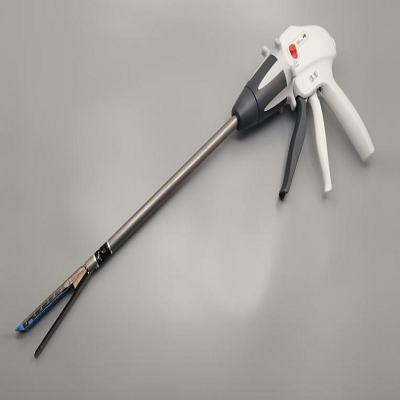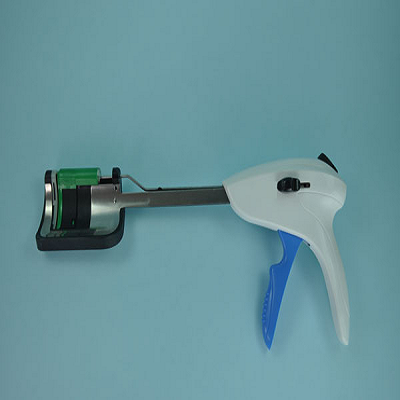The application of circular stapler in gastrojejunostomy and esophagojejunostomy has been widely accepted, and most surgeons prefer to use circular stapler in open surgery. Inaba et al reported that the application of linear stapler in gastrojejunostomy under endoscopy has a good effect. The author prefers straight staplers or even endoscopic staplers for digestive tract reconstruction in open surgery, because:
(1) such instruments are convenient and simple to operate, avoiding the cumbersome operation steps such as pocket-stitched stapler placement and circular stapler traversing the intestinal cavity; (2) Anastomosis is not limited by lumen diameter; (3) There is little bleeding during anastomosis, and it is not easy to cause tissue tear or incomplete anastomosis during anastomosis; (4) Shorten the operation time; (5) Compared with the circular stapler, the linear stapler only needs to replace the nail bin when repeatedly used during the operation, which reduces the surgical cost. As for whether it can reduce the incidence of postoperative complications compared with the circular stapler, further clinical verification remains to be done.
Selection and application of single-use stapler in colorectal surgery
1. Right hemicolectomy ileocolon end-to-side anastomosis: a circular stapler (29 or 33mm) can be used to complete ileocolon end-to-side anastomosis, and a linear closure device (L60 or L75) can be used to close the broken end of transverse colon, or a linear cutting stapler (L75) can be used to perform ileocolon end-to-side anastomosis. A circular stapler (29 or 33) should be inserted in the proximal intestinal lumen during end-to-end anastomosis of transverse colon or left hemicolectomy.
2. Sigmoid colon or rectum resection Colorectum (anal canal) end-to-end anastomosis: Double anastomosis is the most commonly used method in gastrointestinal reconstruction, no matter in laparotomy or endoscopic surgery. This paper mainly introduces the technique of double stapling through anal approach for gastrointestinal reconstruction.
The proximal bowel is placed with a circular stapler against the nail base, and the stapler body should be closed with a straight line or arc cutting stapler at the pre-cut place at the distal end of the tumor. Before entering the anal canal, the front end of the stapler body should be coated with iodor solution to lubricate and disinfect. The body must be slowly advanced in the anal canal until the front end of the body gently touches the inside of the rectal stump.

Note of single-use stapler in colorectal surgery
(1) during stapler tightening, the proximal bowel should be prevented from twisting, otherwise the mesangial vessels will be compressed; (2) The mesangium of the intestinal canal at both ends of the anastomosis should not be too long dissociated to ensure adequate blood supply to the intestinal canal; (3) The fat tissue of the intestine at both ends of the anastomosis should be removed clean to prevent incomplete anastomosis caused by excessive tissue embedding during anastomosis, but it is better not to exceed 2cm, otherwise the blood supply of the intestine at the anastomosis will be affected; (4) During anastomosis, other unrelated tissues should be prevented from embedding stapler, especially in the posterior vaginal wall of female patients. The position of the posterior vaginal wall should be confirmed before the stapler is struck, and vaginal exploration can be performed after the completion of anastomosis; (5) after the completion of the best by charging test or anal injection of methylene blue solution check whether match completely, postoperative anastomotic dre inspection, matches should avoid the overlap of circular and linear stapling anastomosis line, otherwise it will cause anastomotic blood supply is poorer, postoperative anastomotic expression paralysis, often occurred in the use of high frequency electrical knife to avoid damage, rectal and vaginal wall Double anastomosis although widely used, but there are still some defects, such as in circular and linear stapling nail wire overlap, use linear cutting anastomat cutting after bowel loops, can be on the edge of the rectum stub form "Angle" cat ears, especially the intraoperative application of linear cutting closer for many times, can cause anastomosis line overlap, increase the risk of anastomotic fistula. Therefore, in clinical practice, if conditions permit, single anastomosis technique can be used, that is, purse suture can be used for both proximal colonic end and distal rectum, so as to avoid the disadvantages of double anastomosis technique.
The rectum resection of colorectal (anal) end side anastomosis: stapling body can abdominal or anal into the way to complete the end side anastomosis using circular anastomat (33 mm or 29 mm) and linear stapling end side anastomosis formed a colon is the significance of "J form loops, increase the rectum manure storage capacity, reduce the risk of postoperative anastomotic fistula, Brisinda research hair, etc Currently, end-to-end anastomosis is safe and feasible, and the incidence of postoperative anastomotic fistula is lower than that of end-to-end anastomosis. However, the sample size of this experiment is too small, and large-scale clinical trials are still needed to verify it.
Colonic bag-rectal (anal) anastomosis can also be used, in which a j-fold of 6~7cm is made at the free colonic end with a straight cutting stapler. A meta-analysis showed that compared with end-to-side anastomosis, there was no statistically significant difference in postoperative complication rate, mortality rate, defecation function, etc. However, the operation of colon storage bag was complicated and expensive, and the specific choice of the method needed to be decided by the surgeon.
In recent years, the arc-shaped stapler has gradually become popular in clinical practice. Some scholars believe that in the resection of low rectal cancer, the arc-shaped stapler is easier to penetrate into the pelvic cavity than the linear stapler, and the anastomosis effect is better. The author thinks that, two kinds of stapling have their respective characteristics and indications of the pelvic tumor location is low and narrow linear stapling cannot complete enough distance of the distal bowel carvers, consider using arc cutting anastomat, no matter choose which kinds of stapling, must follow the principle of TME, intraoperative dissection clearly, guarantee a good surgical field.

Post time: Nov-29-2021





